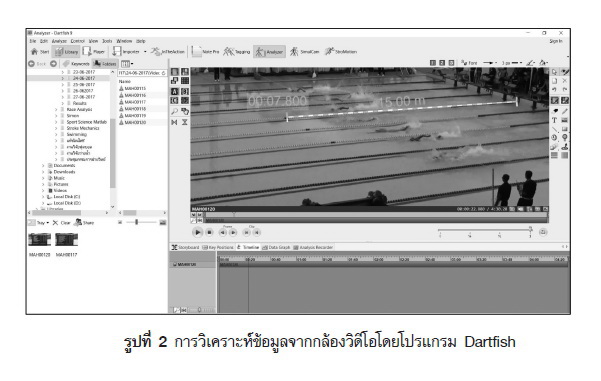AN ANALYSIS OF PACING STRATEGY AND STROKE CHARACTERISTICS IN THE 45th THAILAND NATIONAL GAME
Main Article Content
Abstract
Purpose : To study and compare pacing strategy and stroke characteristics of swimming performance between male and female swimmers in Thailand national games.
Methods : The subjects were 256 swimmers (males 128 and female 128), competing in the final events at the 45th Thailand national game. A single-camera at 50 Hz was used to collect swimming race data. Dartfish software was used to analyze the pacing strategy and characteristics of swimming performance. The mean and standard deviation (SD) of characteristics of swimming performance and percentage of the pacing strategy variables were computed. Independent t-test was conducted to identify differences between male and female swimmers with a significance level of p < .05.
Results : Our results revealed that an average of percentage of clean swimming time was the highest when compared to other pacing strategies (61.94-72.19%). The percentage of start time was higher in short distances (50-100-m) while a turn time was higher in middle to long distances (200-1,500-m) in both male and female swimmers. The swimming strokes were higher in male than female swimmers. Stroke rate was also higher in 50-m breaststroke swimming for male (64.36 cycles/min) and butterfly for female (58.65 cycles/min). No statistical significance difference in stroke length was observed between gender with the highest value in 1,500-m freestyle (2.54-m) for male swimmers and 800-m freestyle (2.26-m) for female swimmers. In addition, the highest stroke index of male swimmers was found in 50-m freestyle (4.61 m2/c.s) and 200-m individual medley (3.87 m2/c.s) for female swimmers.
Conclusion : A pacing strategy and stroke characteristics analysis of swimmers participated in all events at the 45th Thailand national game has demonstrated statistical differences between gender, swimming styles, distance of the races and pacing strategy, The results obtained from this study can be used as guidelines to design a swimming strategy and an individual training program in order to improve swimming performance.
Article Details
References
Arellano, R., Brown, P., Cappaert, J., and Nelson, R. C. (1994). Analysis of 50-, 100-, and 200-m freestyle swimmers at the 1992 Olympic Games. Journal of Applied Biomechanics, 10(2), 189-199.
Arellano, R., Cossor, J., Wilson, B., Cjatard, J., Riewald, S., and Mason, B. (2001). Modelling competitive swimming in different strokes and distances upon regression analysis: a study of the female participants of Sydney 2000 Olympic Games. Paper presented at the ISBS-Conference Proceedings Archive.
Costill, D., Kovaleski, J., Porter, D., Kirwan, J., Fielding, R., and King, D. (1985). Energy Expenditure During Front Crawl Swimming: Predicting Success in Middle-E. International Journal of Sports Medicine 6, 266-270.
Craig, A., and Pendergast, D. R. (1979). Relationships of stroke rate, distance per stroke, and velocity in competitive swimming. Medicine and Science in Sports and Exercise, 11(3), 278-283.
Fleiss, J. L., Levin, B., and Paik, M. C. (2004). Determining sample sizes needed to detect a difference between two proportions. Statistical Methods for Rates and Proportions, 3 rd Edition, John Wiley & Sons, Inc. 64-85.
Foster, C., Snyder, A. C., Thompson, N. N., Green, M. A., Foley, M., and Schrager, M. (1993). Effect of pacing strategy on cycle time trial performance. Medicine and Science in Sports and Exercise, 25(3), 383-388.
Guimaraes, A. C., and Hay, J. G. (1985). A mechanical analysis of the grab starting technique in swimming. International Journal of Sport Biomechanics, 1(1), 25-35.
Jesus, S., Costa, M. J., Marinho, D. A., Garrido, N. D., Silva, A. J., and Barbosa, T. M. (2011). The 13th FINA World Championship finals: stroke kinematics and race times according to performance, gender and event. Portuguese Journal of Sport Sciences, 11(Suppl.2), 275-278.
Lyttle A., Benjanuvatra N. (2005) Start Right? A Biomechanical Review of Dive Start Performance. Available from URL: https://www.coachesinfo.com/category/swimming/321/
Mason, B., and Cossor, J. (2001). Swim Start performances at the Sydney 2000 Olympic Games. Biomechanics Symposia, University of San Francisco.
McCabe, C. B., Psycharakis, S., and Sanders, R. (2011). Kinematic differences between front crawl sprint and distance swimmers at sprint pace. Journal of Sports Sciences, 29(2), 115-123.
Okuno, K. (2003). Stroke characteristics of world class male swimmers in free style events of the 9th FINA world swimming championships 2001 Fukuoka. Biomechanics and Medicine in swimming, 157-162.
Robertson, E. Y., Pyne, D. B., Hopkins, W. G., and Anson, J. M. (2009). Analysis of lap times in international swimming competitions. Journal of Sports Sciences, 27(4), 387-395.
Sanchez, J. A., and Arellano, R. (2002). Stroke index values according to level, gender, swimming style and event race distance. Paper presented at the ISBS-Conference Proceedings Archive Caceres, Exlremadura, Spain.
Smith, D. J., Norris, S. R., and Hogg, J. M. (2002). Performance evaluation of swimmers. Sports Medicine, 32(9), 539-554.
Thompson, K., Haljand, R., and MacLaren, D. (2000). An analysis of selected kinematic variables in national and elite male and female 100-m and 200-m breaststroke swimmers. Journal of Sports Sciences, 18(6), 421-431.
Thow, J. L., Naemi, R., and Sanders, R. H. (2012). Comparison of modes of feedback on glide performance in swimming. Journal of Sports Sciences, 30(1), 43-52.
Tor, E., Pease, D. L., Ball, K. A., and Hopkins, W. G. (2014). Monitoring the effect of race-analysis parameters on performance in elite swimmers. International Journal of Sports Physiology and Performance, 9(4), 633-636.
Vilas-Boas, J. P., Cruz, J., Sousa, F., Conceicao, F., Fernandes, R., and Carvalho, J. (2003). Biomechanical analysis of ventral swimming starts: comparison of the grab start with two track-start techniques. Paper presented at the IXth World Symposium on Biomechanics and Medicine in Swimming. Saint Etienne: University of Saint Etienne.
Welsh, A. H., and Knight, E. J. (2015). Magnitude-based inference: a statistical review. Medicine and Science in Sports and Exercise, 47(4), 874.


